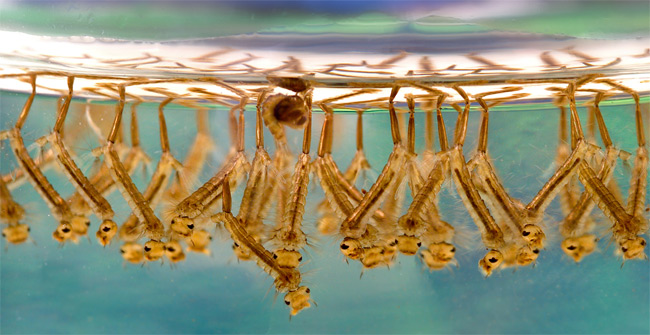The danger when mosquitoes today carry plastic particles in the body
According to Biology Letters, when monitoring the pathway of glowing plastic particles in the ecosystem, British scientists concluded that it is mosquitoes that spread tiny plastic particles from ponds to systems. Other ecology accumulates in the larvae stage.
Later, these plastic particles are found in birds as well as other animals that eat insects and plastic beads can be a major danger to them.

Mosquito mosquito Culex - Photo: James Gathany / CDC.
Mosquito larvae live in ponds and eat tiny food particles that are readily available in the water. At the same time, they do not select food: to feed themselves, they simply crawl over the water, thereby creating a stream of water that carries food particles directly into the mouth, without filtering. Along with the pieces of food, the smallest plastic particles also enter the larvae. Scientists have tracked the path of these particles in the larvae 's body and then in the adult mosquitoes.
Scientists have experimented by adding yellow and blue glowing plastic beads (about a few micrometres in size) to water containers with mosquito larvae released. As the larvae developed, scientists discovered the accumulation of glowing plastic in the malpighia capillaries of insects, an organ similar to kidneys in humans.
Thus, the smallest plastic particles must not be released from the larval body and remain in the insect's body, even if the larvae become mosquitoes. Adult mosquitoes carry particles that accumulate into new habitats and become food for larger insects, birds . According to scientists, this can be dangerous for many insects. shallow and underwater.
- Mosquitoes are the main cause of microbial contamination of animals?
- Detecting micro-plastic particles in rainwater, not only lies in the sea
- Microplastics threaten the offspring and their food source
- Each person swallowed at least 50,000 micro-plastic beads every year
- Startled with the amount of plastic you are eating into your mouth every year
- 90% of salt samples in the world contain micro-plastic
- Discovered billions of microscopic particles in tea filter bags
- First detected human body
- Detects micro plastic particles in a range of bottled water products
- Are we eating plastic waste daily?
- Interesting findings about mosquitoes
- Scientists find the world's first reusable plastic
 Why do potatoes have eyes?
Why do potatoes have eyes? 'Tragedy' the world's largest carnivorous life: Death becomes ... public toilet
'Tragedy' the world's largest carnivorous life: Death becomes ... public toilet Tomatoes were once considered 'poisonous' for 200 years
Tomatoes were once considered 'poisonous' for 200 years Detecting microscopic parasites on human face
Detecting microscopic parasites on human face New discovery about the huge energy source in cosmic rays
New discovery about the huge energy source in cosmic rays  Physicists find the first clue about 'colloidal particles' - a type of particle formed by force
Physicists find the first clue about 'colloidal particles' - a type of particle formed by force  The solution is to shoot salt into the sky to block the sun
The solution is to shoot salt into the sky to block the sun  CERN's large particle accelerator detects 3 new subatomic particles
CERN's large particle accelerator detects 3 new subatomic particles  'Demon Particle' from another dimension appeared all over the Earth?
'Demon Particle' from another dimension appeared all over the Earth?  For the first time, microplastics were found in human blood
For the first time, microplastics were found in human blood 